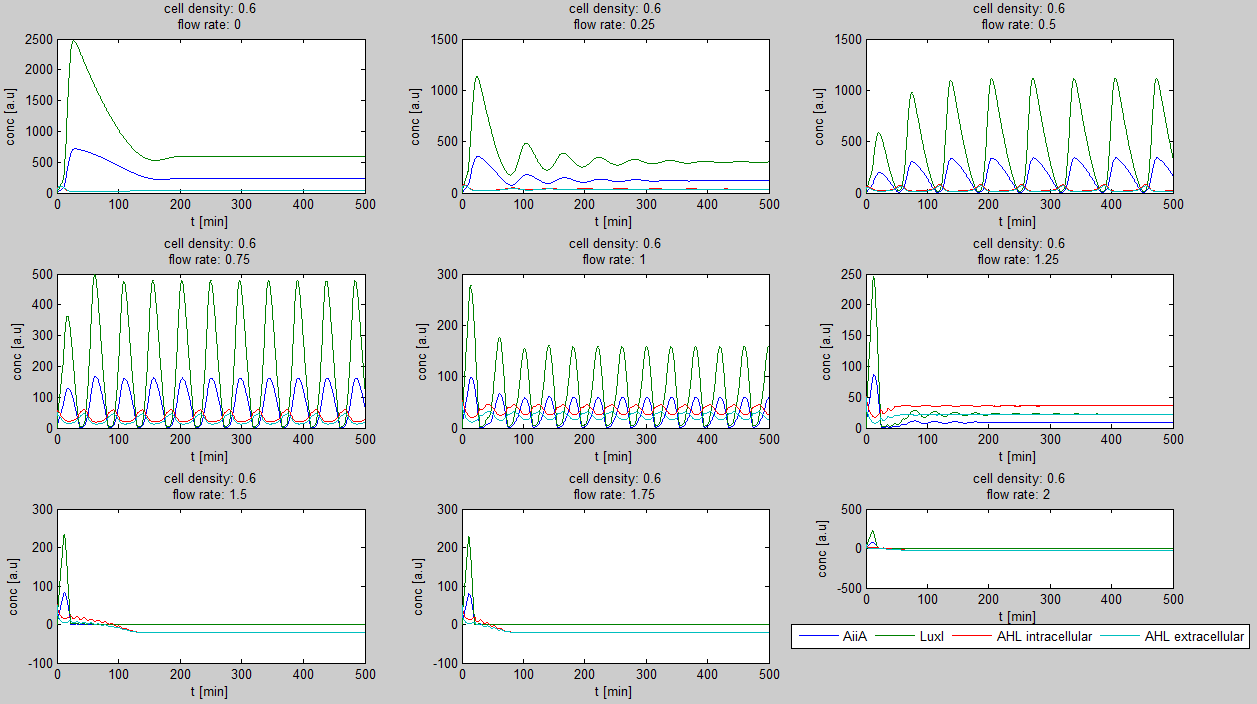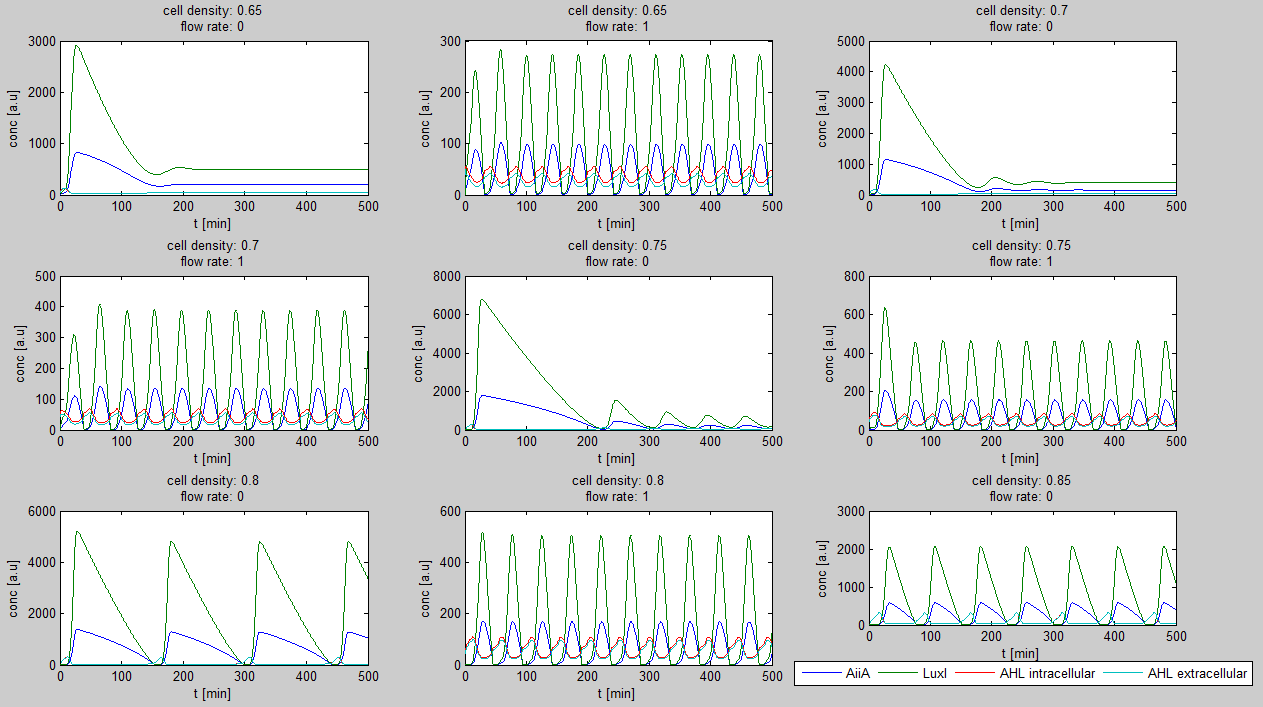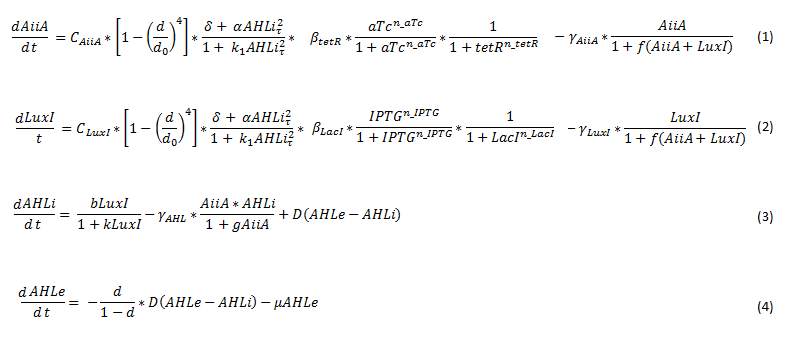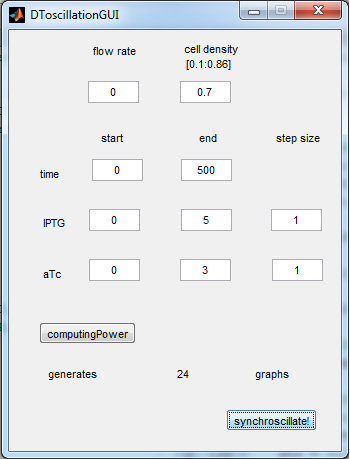Team:Wageningen UR/Project/ModelingProj1
From 2011.igem.org
(→Modeling synchronized oscillations) |
(→Modeling synchronized oscillations) |
||
| Line 67: | Line 67: | ||
{{:Team:Wageningen_UR/Templates/Style | text= __NOTOC__ --> | {{:Team:Wageningen_UR/Templates/Style | text= __NOTOC__ --> | ||
| - | The steps (transcription, translation, maturation etc.) from the luxI and | + | The steps (transcription, translation, maturation etc.) from the luxI and aiiA genes to the corresponding proteins are not modeled separately. Instead, the delay of the correlation between the internal AHL concentration, which triggers the expression of the genes, and the corresponding AiiA and LuxI concentrations is simulated by a Hill function. This Hill function takes the history of the system into account, i.e. the concentration of AHL at the time it binds to LuxR to form the activation complex. |
| Line 93: | Line 93: | ||
--> | --> | ||
| - | For the first simulations, the same parameters were used as in the cited paper | + | For the first simulations, the same parameters were used as in the cited paper, the only variables thus being the cell density and flow rate. To get an idea about the different conditions in which oscillations could occur, our team created a script for a Matlab modeling tool which uses nested for-loops to vary the flow rate and cell density over a range of values. The resulting tool allows the user to enter the range in which the variables should be varied. The script then iterates over the values and plots graphs of all combinations possible for that range of values. Figure 2 shows an example output of the script. |
| Line 107: | Line 107: | ||
=== Preliminary conclusions for our system === | === Preliminary conclusions for our system === | ||
| - | The first observation from the model was that, for oscillations to occur, the flow rates may not be too fast, especially at lower cell densities. Since the device used for our system has larger dimensions than the microfluidic device used by Danino et al. the flow rates required could not be achieved by varying height differences alone. <!-- Further information can be found in the information about the [[Team:Wageningen_UR/Project/Devices#Setup| platform used to measure oscillations.]] --> | + | The first observation from the model was that, for oscillations to occur, the flow rates may not be too fast, especially at lower cell densities (see output graphs above). Since the device used for our system has larger dimensions than the microfluidic device used by Danino et al. the flow rates required could not be achieved by varying height differences alone. <!-- Further information can be found in the information about the [[Team:Wageningen_UR/Project/Devices#Setup| platform used to measure oscillations.]] --> |
Furthermore, an interesting observation was that applying a flow rate over the cells was not essential to obtain oscillations. Figure 3 shows how, according to the model, oscillations can potentially occur at 0 flow rate. Interesting is that this happens only at high cell densities. | Furthermore, an interesting observation was that applying a flow rate over the cells was not essential to obtain oscillations. Figure 3 shows how, according to the model, oscillations can potentially occur at 0 flow rate. Interesting is that this happens only at high cell densities. | ||
| Line 119: | Line 119: | ||
=== Expansion of the model for the double tunable oscillatory construct === | === Expansion of the model for the double tunable oscillatory construct === | ||
| - | To model the [[Team:Wageningen_UR/Project/CompleteProject1Description#Designs| double tunable oscillator]], the original set of delay differential equations was expanded. This involved adding the effect of the repressor and activator in the form of a Hill function to the differential equations for LuxI and AiiA. The equations for the internal and external AHL concentrations were not changed. The new set of equations is seen below. | + | To model the [[Team:Wageningen_UR/Project/CompleteProject1Description#Designs| double tunable oscillator]], the original set of delay differential equations [2] was expanded. This involved adding the effect of the repressor and activator in the form of a Hill function to the differential equations for LuxI and AiiA. The equations for the internal and external AHL concentrations were not changed. The new set of equations is seen below. |
[[File:Equations_enhanced_WUR.png]] | [[File:Equations_enhanced_WUR.png]] | ||
| Line 125: | Line 125: | ||
'''Top: ''Adjusted set of differential equations for the double tunable oscillator'' | '''Top: ''Adjusted set of differential equations for the double tunable oscillator'' | ||
| - | Since the lacI repressed hybrid promoter used for this system was designed by the Tokyo iGEM 2007 team [3], the additional terms were derived according to their model. The tetR repressor was then modeled using the same template. | + | Since the lacI repressed hybrid promoter used for this system was designed by the Tokyo iGEM 2007 team [3], the additional terms were derived according to their model. The tetR repressor was then modeled using the same template. The set of equations seen above therefore integrates the features of both models. |
This set of equations was then used to write a new matlab modeling tool, of which the GUI is depicted below. | This set of equations was then used to write a new matlab modeling tool, of which the GUI is depicted below. | ||
| - | [[File:GUI_2_synchroscillator_WUR.png|300px|center]] | + | [[File:GUI_2_synchroscillator_WUR.png|300px|center]] |
| + | |||
| + | As can be seen in the GUI, the new model allows the construct to be controlled by changing the values for IPTG and aTc. The parameters used are still in arbitrary units and the values not yet verified with wet lab experiments. However, some example conditions were simulated, of which the output graphs are seen below. | ||
| + | |||
| - | |||
'''Links and references:''' | '''Links and references:''' | ||
Revision as of 19:39, 21 September 2011
 "
"






